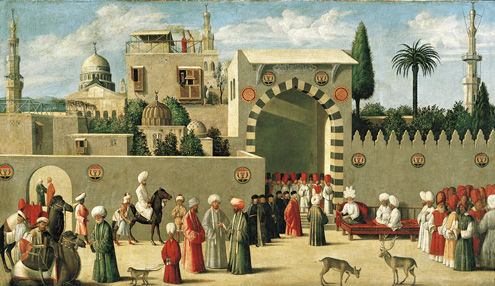The latest Islamic tastes were often reflected in the homes of the richest Venetians, for whom luxury objects from the East became desired collectibles. Islamic art and architecture also influenced Venetian painting. Artists who traveled to Islamic lands were fascinated by the people, garments, and architecture they saw there and sketched them in meticulous detail. Many brought their drawings back to Europe, where they circulated widely in artistic circles. Such sketches influenced a whole generation of painters and led to the popularity of Eastern scenes and costumes in Venice (fig. 56). Venetian paintings, particularly of biblical subjects, incorporated settings inspired by Mamluk Egypt and Ottoman Turkey. In addition to artistic influence, the Islamic world also contributed to the scientific growth of Venetian culture. Many of the classical astronomical and mathematical treatises known in Venice were originally introduced through Arabic translations. (See Science and the Art of the Islamic World.) These various connections left a very tangible legacy in Venice; by the nineteenth century, some of the most important and largest collections of Islamic art were in Venetian hands.

Fig. 56. Reception of the Venetian Ambassadors in Damascus, 1511; Venice; oil on canvas, 46 1/2 x 80 in. (118 x 203 cm); Musée du Louvre, Paris
RELATED AUDIO FROM THE GALLERY GUIDE
Walter Denny: Ottoman velvets were for the most part woven not in Istanbul, but in the old Ottoman capital and important provincial center of Bursa. Bursa velvets were used extensively as costumes and vestments by Europeans, especially by Russians. But in the Ottoman Empire, they were used almost exclusively not for costumes, but as furnishing fabrics. Among the most beloved genres of Ottoman furnishing fabrics was the yastik, or flat bolster cover, sometimes with a medallion and sometimes with repeated designs and with a characteristic end finish of lappets or flaplike forms in which small palisades containing flowers—carnations, or tulips, or rosebuds—are frequently visible. These yastiks, or furnishing fabrics, were used to make cushions that would be used on the sofa found as built-in furniture in Ottoman living rooms.
Bursa velvets, unlike Persian velvets, always show us a very limited palette. Generally there is one ground color, overwhelmingly red, with little accents of green, and then the background, which today appears white, in the original was almost always heavily brocaded with silk wrapped in silver.
Thomas P. Campbell: The white would have been brilliant and glistening.
| Previous Section | Next Section |